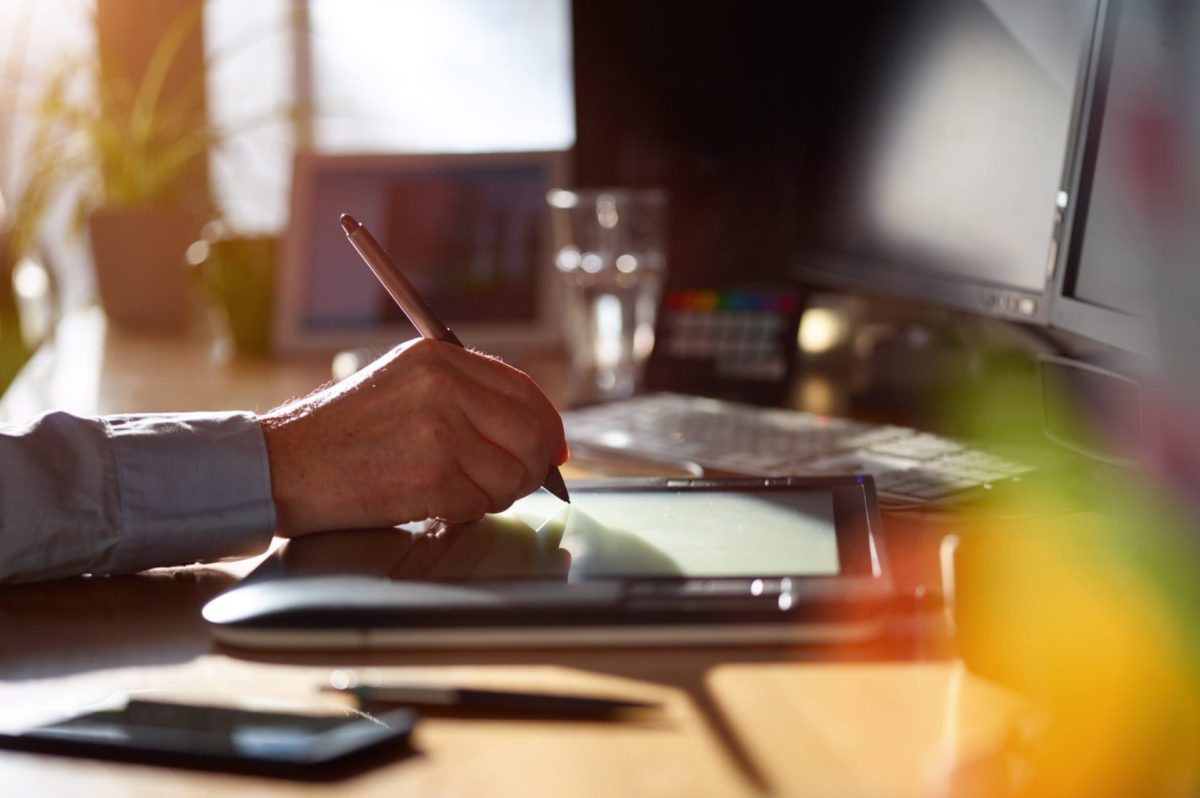Content
Project activities always have some difficulties underneath. One of which is precisely the choice of the development approach and following it. That is why the RewiSoft team decided to make an in-depth guide on the design cycle as one of the most comprehensive approaches to developing both software and web solutions.


This guide will be helpful for both development teams and their management, as it has detailed descriptions of each step and live examples where you can follow the cycle design. First, however, what’s there to pull, let’s figure it out together with what a design cycle is.
Read More: Quick Guide to Digital Product Design and Development [Based on 150+ Cases]
Design Cycle: Detailed Overview
We think it is worth defining what a design cycle is for a clear understanding of what we are dealing with.
The design cycle combines steps that take your project from a design idea to a finished, workable product. Of course, each designer can have their approach to solving the problem, but selecting the best system is the first step of the systems creative design phase of the systems life cycle.
The life cycle design in project management stems from the agile model theorized in the 1990s, making it possible to represent development processes in a cycled manner and successive phases. This project management model was developed in the 1990s, applied to industrial projects, and then extended to IT projects.
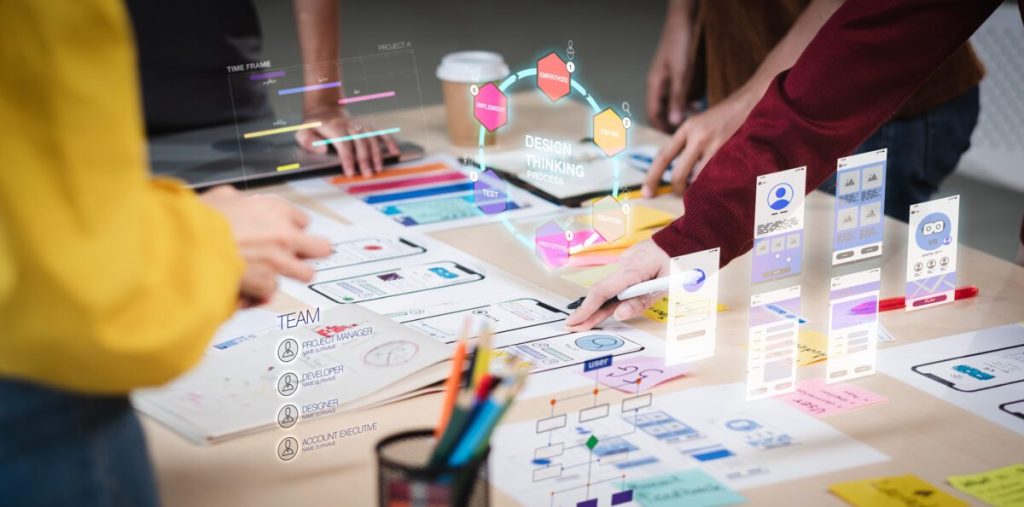

The process is divided into four base phases: system analysis and design life cycle, idea development, solution creation, and evaluation. This process allows the developer to move from identifying design feasibility to testing and evaluating the solution. The design cycle is an interactive and flexible process that will enable teams to continually return to previous steps to solve a particular problem or problem.
Read Also: Web App Design: Tips, Trends, and Examples
Why is this methodology so successful?
The main advantage of the design cycle is that it avoids most mistakes that can drag on throughout development due to repeatable processes. Nevertheless, each design stage requires accurate and comprehensive documentation, where a particular result must confirm each point. Once a step is approved, we move on to the next step on a solid footing but can come back if necessary.
With its rigorous and intuitive aspect, the design cycle remains an easy process to implement. The preliminary work of defining the design specifications at the beginning of the project means that all stages are known to the employees after the launch, who can easily navigate the project time frame and see the purpose of their tasks. Likewise, the documentation required for each step can be replicated from one project to another in its structure (design specifications, test specifications, etc.).
And another essential advantage of working with the design cycle is that the team avoids the “tunnel effect” during development. That is, even if the original specifications are exceeded, or the customer’s need has changed or was poorly expressed, the team can always go back to previous steps and make changes. Thus, the design cycle works great with changes, which is its strong point.
Read Also: Mobile App Design Cost: Calculate Your Design Cost In 10 Min
What are the practical benefits of the Design Cycle methodology?
First of all, the design process cycle is a comprehensive approach to development, which aims to maximize the organization of the work. Still, in addition, it brings some more pluses in development.
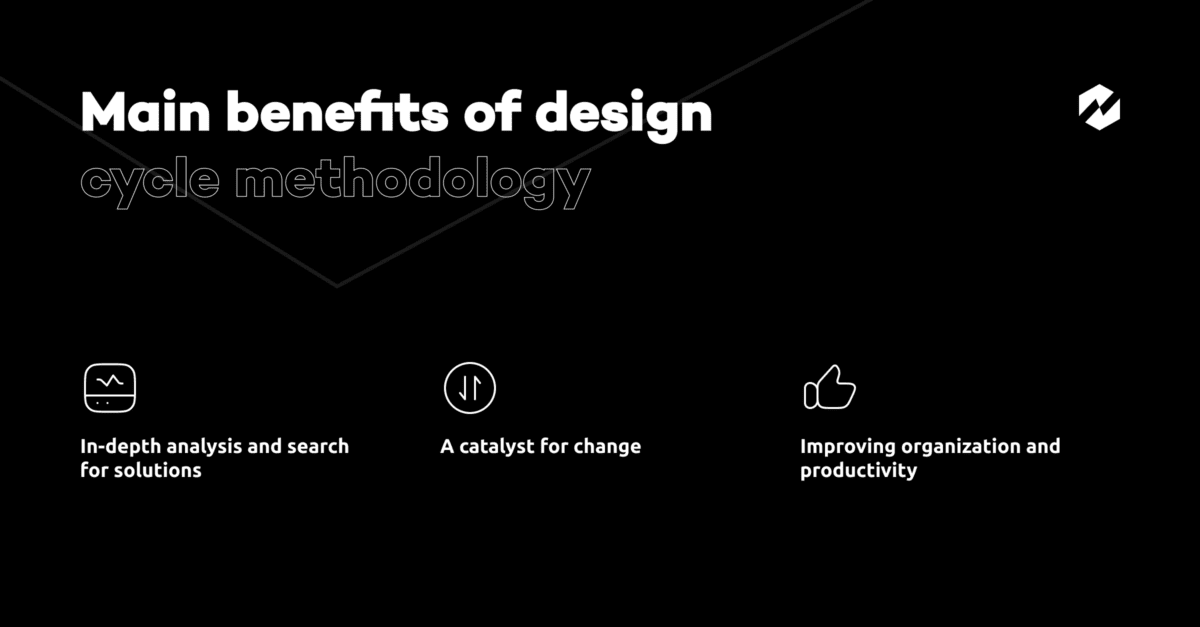

In-depth analysis and search for solutions
The core of the design cycle is an interest in understanding the people for whom the team develops the product. This helps observe and develop empathy with your customers. And it also shapes the process of constant searching – questioning the problem, questioning assumptions, and critiquing solutions. This is extremely useful in solving any issues in the development process.
The team comes to these solutions by rethinking the problem in a customer-centric way, developing ideas, and taking a hands-on approach to prototyping and testing. And what’s more, the design cycle is an iterative and flexible process of continuous experimentation: sketching, prototyping, testing, and trying out concepts and ideas.
A catalyst for change
It’s also worth noting that the design cycle is an excellent catalyst for change. It’s perfect for creating a space for the productive exchange of ideas and creating innovative solutions with the broadest support from the start.
Improving organization and productivity
The design cycle can also help create the right environment for your customer’s objective and broader understanding. It helps move beyond one-sided research and begins an ongoing process of dialogue with current and potential customers if it includes prototyping and testing. It helps shift the focus of innovation and discovery from the bias of intuitive thinking to the inclusiveness of empathic thinking.
Related Reading: Essentials of App Redesign [A Detailed Guide]
Six main steps of Design Cycle
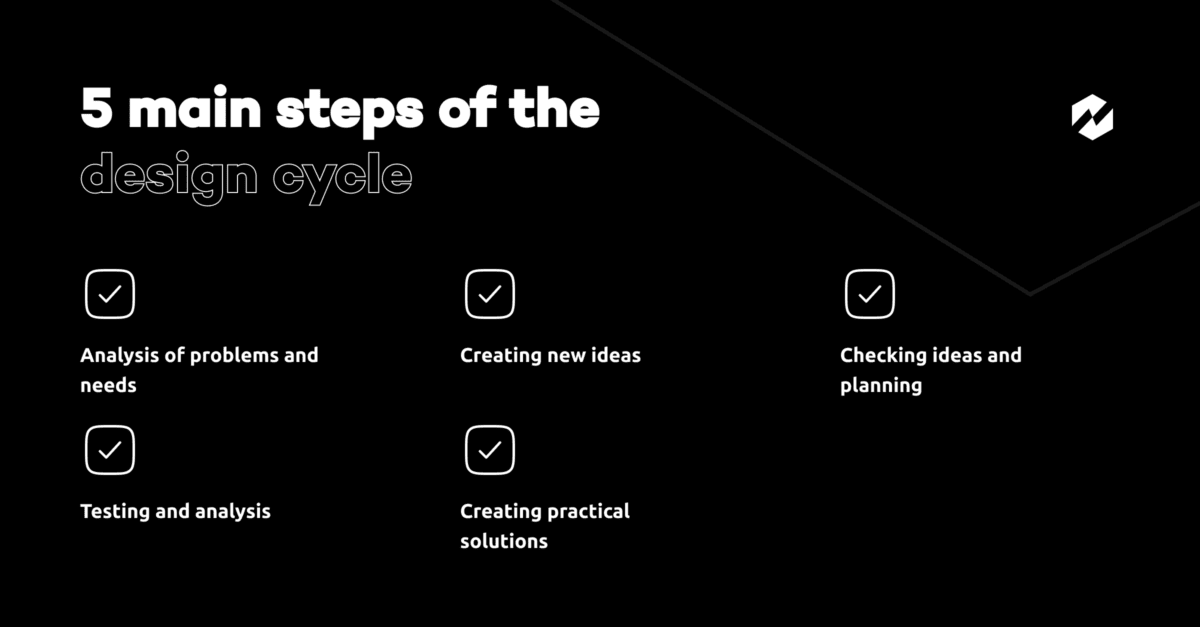

Analysis of problems and needs
As with any endeavor, the design cycle starts with setting design goals. At the very beginning, you need to answer one of the most critical questions, “Why such a design is necessary,” analyzing problems and needs. This definition of goals will help prioritize future design.
And when you have a clearly defined goal, it is fashionable to move on to analysis. An analysis is a basis that should be as thoroughly worked out as possible. At least 1/4 of the entire analysis step should be devoted to the initial research. First, you must analyze your target audience and market for competition. The analysis of competitors and similar products will be instrumental in creating your unique ideas. Explore what works for them and see if you can use your new ideas.
Read Also: How To Create A Task Management System Design? [Ultimate Guide]
And after the initial analysis has been carried out, the next step is the cycle development plan. It can be represented as follows:
- Set tasks and goals
- Plan for solving the main problem
- Resume regarding target audience and market
- Information about competitors
- Budget and timeline
- The complexity and scale of the project
- Target characteristics of the product
Creating new ideas
And after forming a plan and doing analysis, it’s time to develop your ideas. New ideas or new visions for existing solutions will be helpful when you want to explore different and diverse solutions to your users’ problems.
You can achieve this in a variety of ways. These include brainstorming with your team, borrowing ideas from competitors, running them through your vision, and visualizing them through sketches. There are a great many approaches, and it all depends on the project and your creativity.
However, remember that every idea must pass criticism. And it’s best to offer several design ideas. So your team can notice flaws that you haven’t seen. And that way, you’ll get an idea close to perfect, with which you can move on to the creation stage.
With us, you will be in trustworthy hands
Checking ideas and planning
And once the idea is approved, your next step is the design plan. It is through planning that the project will follow a well-defined path.
Such a plan will guide the development and recommend the entire team to who is responsible for what. However, a plan is a very individual thing, and you will not find two similar plans in the design cycle. So here we can only outline general guidelines for the design cycle plan:
- The path to a working prototype
- Roles and tasks of each team member
- Timeline for project development
- Metrics
- Testing methods
Creating practical solutions
The next step in evaluating your design is to create a working prototype. This prototype is most susceptible to change as initial testing occurs. That’s why you should make it as functional as possible, but not waste time on “visual polishing.
Your goal is to create a platform for evaluation and testing. A simple and good example would be a prototype UX example. Here the task is straightforward – show the basic functionality, make it clear and understandable.
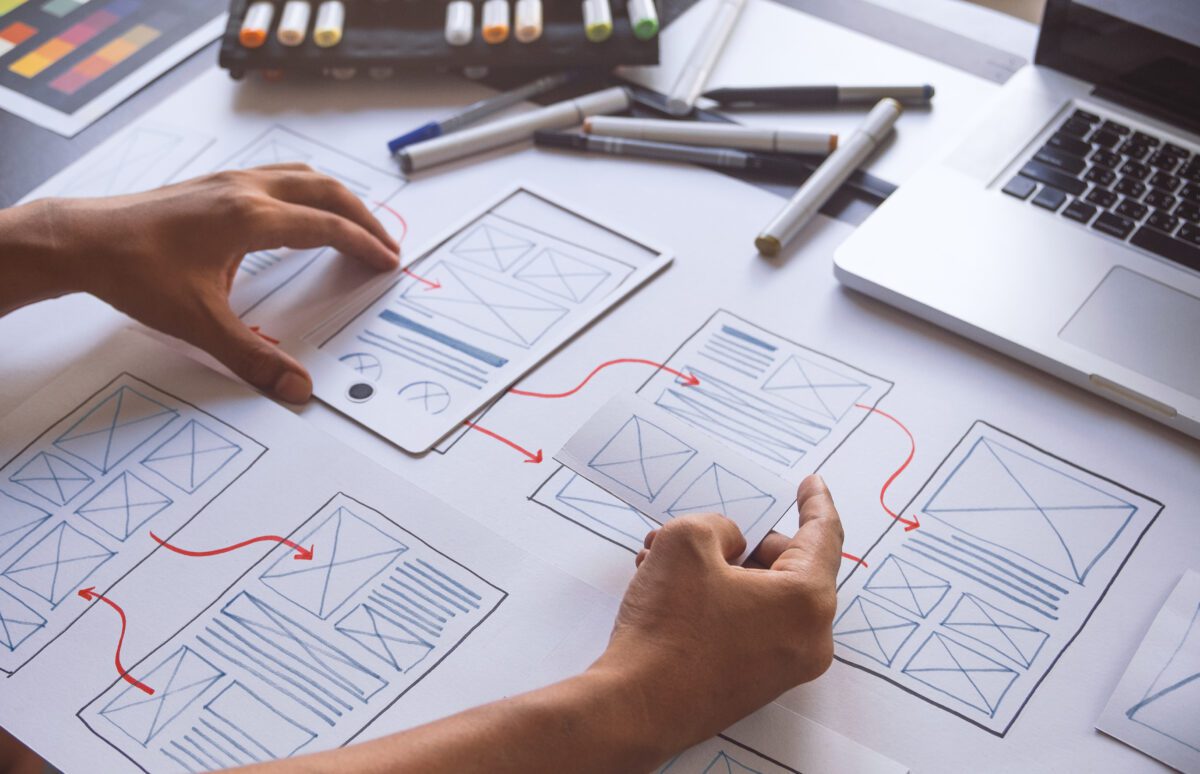

Testing and analysis
The next step in order, by no means in meaning, is the testing stage. To obtain the most impartial metrics, it is necessary to establish testing methods for usability and formulate precise scenarios to observe how your users are engaging with your prototype.
The goal of testing and evaluating is to see how people use a product, get feedback, talk it over with your team, and improve your design. By analyzing the data acquired from the testing methods, you can make informed decisions about what modifications are required.
What’s interesting about design is that the finished product can be completely different from what was presented at the beginning of the design cycle. As a result, the design process can take you down unexpected paths or into unforeseen territory.
What is the Web Design Cycle?
Web development is no less popular than any other direction of development. However, in some ways, the website design life cycle differs. For example, the total number of web design cycle steps usually varies from five to eight, but the picture remains about the same in general.
The steps included in Web Design Cycle:


#1 Product discovery
Product discovery is the most critical step in the web design cycle. It is with this begins – the way will be formed each subsequent phase of web development. At this stage, everything starts with setting clear goals that you want to achieve, choosing the target audience, market and competitor analysis, etc.
And at this stage, documentation is formed, which should also specify the type, purpose, and functionality of the future website (for example, what information or services it will provide). The detail in the documentation can prevent future costly “hot” changes once you start working on the project.
#2 Information Architecture
When you have gathered all the necessary information, it’s time to develop the information infrastructure of the site. It will serve as a kind of guide for developers. This is a guide that describes what content will be on the site and an easy-to-understand navigation system. It will also contain a list of all the sections of the site. But this is only about the internal architecture of the site, not the UI/UX.
And in addition, at the stage of forming the information architecture, it is worth laying down what programming language, content management system (CMS), interactive forms, and frameworks should be implemented. Choosing the right technology stack is crucial for seamless user interaction.
#3 UX Design
Since the previous step doesn’t touch UX and UI, it’s worth going into more detail. In the design process of shaping appropriate UX, it’s worth taking into account the data you’ve already collected about potential customers and competitor products. This will help form a design that will work. And to develop design ideas will help you with wireframe models. Wireframe models give you an idea of the pages of a website. So take advantage of wireframe tools.
Read Also: How Much Does Product Design Cost? [Quick Estimate]
#4 UI Design
Now it’s time to create a graphic design for your site. It would be best to take care of the color scheme, company logos, all possible images, etc. At this stage, the designer should animate the graphics, typography, colors, animations, buttons, drop-down and pop-up menus, and more, according to the project’s requirements.
The same key factor taken into account in the previous steps plays a role here: the target audience. A website designed for a financial institution will be different from a website aimed at millennials, both in appearance and feel. If the design is trivial, the website will fail to capture the user’s attention, increasing the bounce rate. Elements should reflect the brand image as well as the vision of the business.
#5 User Testing
The final stage of the web design cycle is testing. Testing is done on all relevant browsers and platforms. This will assure you that your site is cross-platform. In addition, testers should check functionality, compatibility, and performance to make sure the website is ready to go. Other testing includes integration testing, stress testing, scalability, and load testing. Finally, and complies with the primary objective of providing the full functionality of forms and scripts, regardless of how the website is viewed.
User testing can also be applied. The purpose of such a test is to analyze the actual user experience. There are many different ways to conduct such activities: group testing, testing a single user’s behavior, etc. But the result is worth it. You will get objective data, which will be possible to use in further development.
How does the Design Cycle work in practice?
Let’s simulate an abstract situation. A company wants to launch something new on the market not to lose ground to a competitor. So, after a competitor analysis phase, the list of requirements for the project appears: “A solution that is similar to what the competitors have, but at a lower price, but at the same time the product should be more user-friendly. And all this in a fairly short time so as not to lose ground in the market.”
In terms of dry instructions, everything was done correctly. Competitors and the target audience were analyzed, problems were identified, and possible solutions were proposed. But it’s impossible to implement this in a tight timeframe. And the decision to use the design cycle will be the only right decision. This approach will help the team focus on the things that will benefit the end-user and thus defeat the competition by providing the client with only what they need.
Read Also: Between Subjects Design: What, Why, and How?
And when the potential audience is attracted and a firm position in the market is achieved, the main features of the design cycle – flexibility and iterability – will come into play. The team will be able to return to implementing additional features and go through the whole. design process with them without affecting the already in operation prototype.
RewiSoft Examples
And, of course, the guide wouldn’t be complete without a RewiSoft example`s demonstration.
The RewiSoft team worked on the Referrizer platform.
It’s a marketing automation platform that helps attract new customers, increase repeat purchases, and provide long-term sustainable results. This communication platform increases referrals, increases retention, and improves a company’s reputation on Google.
And the first thing that was done at the client’s request was to form a digital strategy. The main goal of which was to get leads and attract large companies to the Referrizer platform. Also, Referrizer’s target audience was analyzed. These are the owners of small local businesses and their employees.


Referrizer needed a quality reputation management module, which should consist of four blocks: dashboard, review enhancer, review management, review widget. Referrizer also needed an adaptive design for this module.
And based on the results of the analysis and the client’s wishes, Northel developed an attractive platform for referrals. Such colors as white, blue, and blue were used. And also, on the pages, visual accents were made so that the user’s attention was drawn to the necessary blocks.
[article_idea title=”Have an idea of the next great project?” btn_text=”We can bring it into reality!” btn_link=”/get-estimation”]We Are The Top 20 Product Designers & Developers on Clutch[/article_idea]
Why is the right approach essential in the Design Cycle?
Design Cycle allows organizations to create enduring value for consumers. This process is helpful in any complex system.
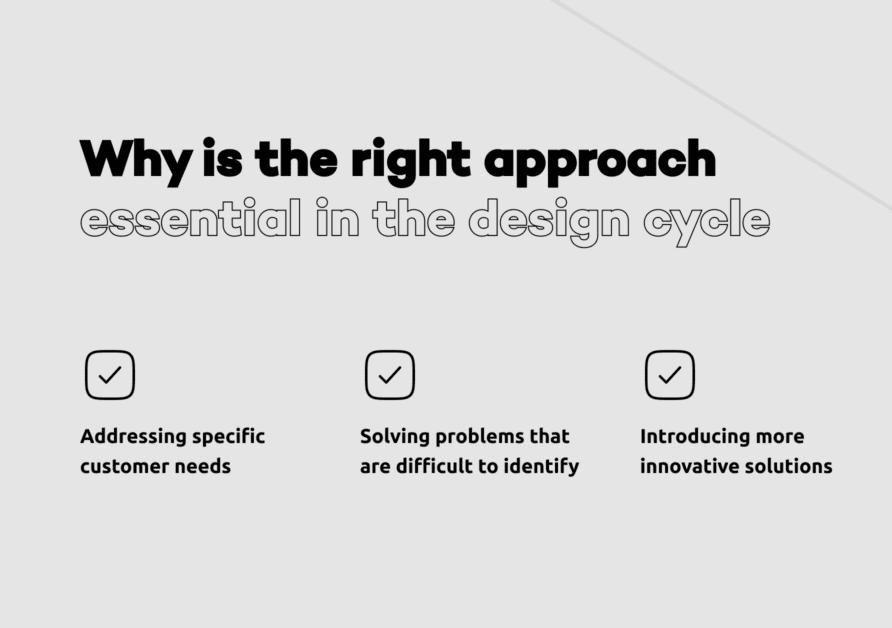

Addressing specific customer needs
During the analysis phase, the team can identify consumer needs that they didn’t even know they had. Then, the design cycle can provide solutions to these needs once they are identified.
Solving problems that are difficult to identify
Consumers often don’t know what their problem needs to be solved or can’t put it into words. But a detailed analysis can identify problems based on what they see as actual consumer behavior, rather than just working off their consumer perceptions. This helps identify ambiguous difficulties and, in turn, makes it easier to find solutions.
Introducing more innovative solutions
Using an iterative approach to solving different user problems often leads to non-obvious innovative solutions.
Faster and more efficient operation
Design Cycle aims to create prototypes and then initial testing occurs to see how effective they are, instead of taking a long time to research a problem without coming up with a result.
Read Also: How To Write The Design Specification? [Quick Guide]
Top 5 Mistakes Working with a Design Cycle
Even with such a flexible system as the design cycle, the development process cannot do without mistakes. We should consider the most common ones.


Failure to understand the target audience
User-centered design is the base that inherently represents the user. And with the help of design, the team must build an empathic relationship with the user who uses the product. That way, a trusting relationship is established. And a loyal audience is one step to success.
Attempts to do better in everything than competitors
Since the design cycle is an iterative and cyclical approach, it seems like you can do everything in one cycle. But therein lies the mistake. It is better to focus on the main thing, on what is most important to the client, in the first cycle, and in the next iterations, finish all the other points.
Ignoring the importance of usability
If a product is beautiful but entirely inconvenient for use, you can’t expect success with users. Plus, properly investing in usability yields a positive conversion rate, saves money, and reduces the bounce rate.
Read Also: What is a Product Design Process? [All You Need to Know]
Lack of following trends
Keep in mind that the project is being implemented as part of a business. Therefore, it’s essential to be aware of user trends and always look for new trends that dictate user behavior and govern how users will respond to your design at any given time.
Neglecting Automation
Often, we underestimate, neglect, and sometimes don’t trust the technology that surrounds us. Tools and supporting software already help automate the testing and research process, removing the exhausting and tedious part. The software can help us analyze user data much more efficiently and faster to get results you may not have known about. What’s good about automating data is that users generate it themselves. They can use sophisticated algorithms to compare data sets, interactive heatmaps, actions, and records that will simplify and give a complete view of the data as they interact with the user.
Summary
You should never forget that website development does not start immediately with writing code and does not end with launching it. The design cycle includes specific steps that must be followed to get a good result.
RewiSoft has given you detailed instructions for each stage of the cycle, and hopefully, you’ll apply them well.

